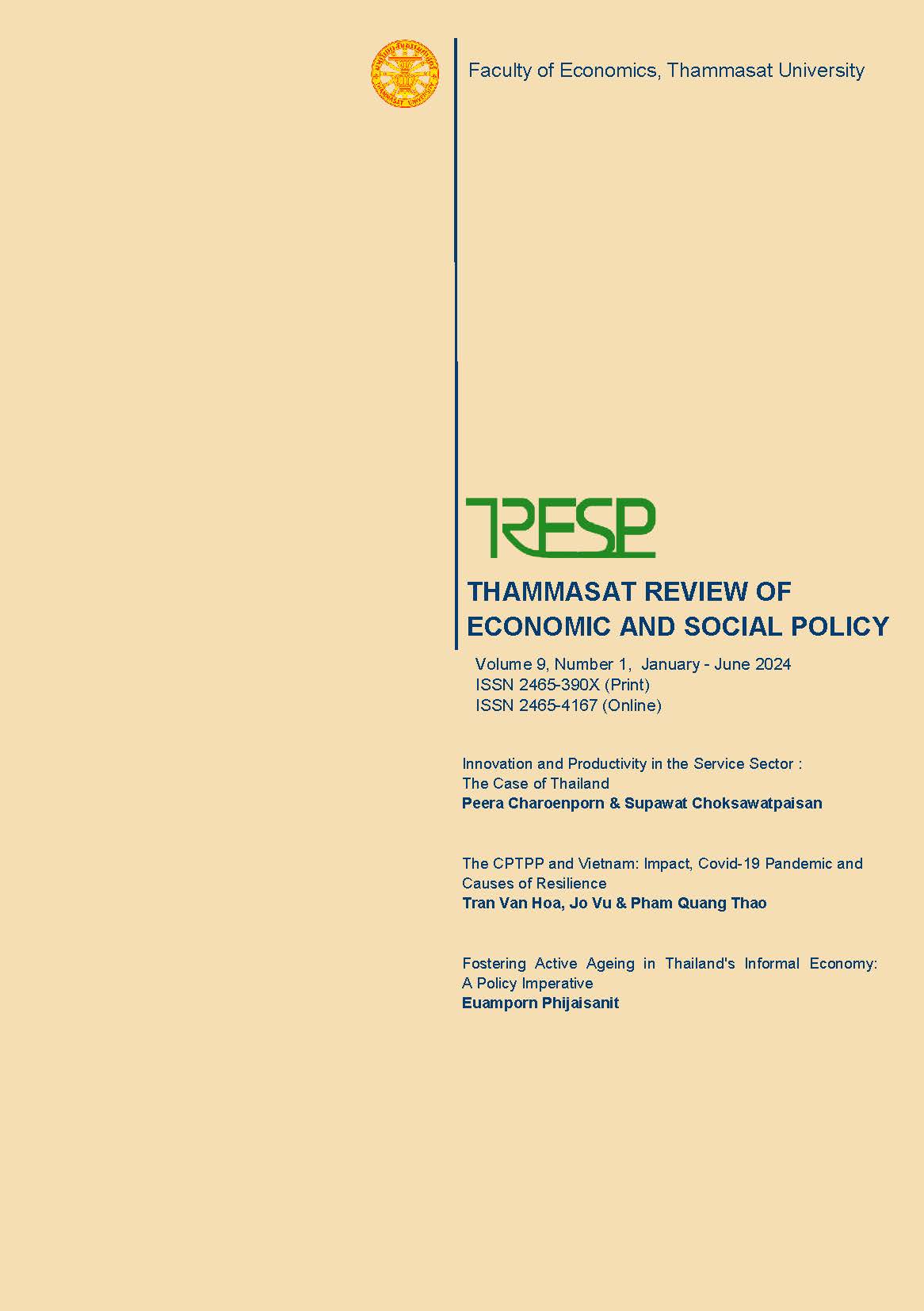Innovation and Productivity in the Service Sector: The Case of Thailand
Keywords:
service sector, innovation, R&D, productivity, CDM modelAbstract
Various literature investigates the determining factor of research and development (R&D) and the impacts of R&D on firms' innovation performance and productivity. However, most available studies focus on manufacturing firms; little is considered about firms in the service sector. The gap is more evident in the case of service firms in developing countries. This study analyzes the data from the Thailand R&D/Innovation Survey 2011–2018 and applies a structural model that describes the link between R&D expenditure, innovation output, and productivity (the CDM model). The study found a link between R&D activities, innovation output, and productivity in the service sector. The results show that firms with higher R&D intensity tend to offer superior innovation performance. Firms' characteristics and behavioral factors, such as size, openness strategy, foreign share, and exporting behavior, increase the propensity to invest in R&D activity. In addition, innovation output has a positive impact on firm productivity. This study highlights the importance of promoting R&D activities and innovation as the basis for improved productivity of service firms in Thailand and highlights some differences in R&D activities and innovations between the service sector and the manufacturing industry.
References
Aboal, D., & Garda, P. (2016). Technological and non-technological innovation and productivity in services vis-à-vis manufacturing sectors. Economics of Innovation and New Technology, 25(5), 435-454.
Asian Development Bank. (2012). Asian Development Outlook 2012 Update: Services and Asia's Future Growth. Asian Development Bank.
Chaminade, C., & De Fuentes, C. (2012). Competences as drivers and enablers of globalization of innovation: the Swedish ICT industry and emerging economies. Innovation and Development, 2(2), 209-229.
Crépon, B., Duguet, E., & Mairessec, J. (1998). Research, innovation and productivi [ty: an econometric analysis at the firm level. Economics of Innovation and new Technology, 7(2), 115-158.
Crespi, G., & Zuniga, P. (2012). Innovation and productivity: evidence from six Latin American countries. World development, 40(2), 273-290.
De Fuentes, C., Dutrenit, G., Santiago, F., & Gras, N. (2015). Determinants of innovation and productivity in the service sector in Mexico. Emerging Markets Finance and Trade, 51(3), 578-592.
Drejer, I. (2004). Identifying innovation in surveys of services: a Schumpeterian perspective. Research policy, 33(3), 551-562.
Ebling, G. (2000, November). Panel Estimation of Activities in the Service Sector. In DG Enterprise Conference on Innovation and Enterprise Creation: Statistics and Indicators.
Evangelista, R. (2000). Sectoral patterns of technological change in services. Economics of innovation and new technology, 9(3), 183-222.
Gallouj, F., & Weinstein, O. (1997). Innovation in services. Research policy, 26(4-5), 537-556.
Griffith, R., Huergo, E., Mairesse, J., & Peters, B. (2006). Innovation and productivity across four European countries. Oxford review of economic policy, 22(4), 483-498.
Hauknes, J. (1996). Innovation in the Service Economy. STEP rapport/report, Oslo, December.
Den Hertog, P. (2010). Managing service innovation: firm-level dynamic capabilities and policy options. Utrecht: Dialogic Innovatie & Interactie.
Kohphaiboon, Archanun (2018). Thai service sector and its role in driving the economy. The 40th Annual Academic Conference of the Year 2018 of the Faculty of Economics, Thammasat University on the topic "Re-design Thailand How to make the Thai economy grow sustainably?" January 2018. (in Thai)
Lasserre, P. (2011). Global Strategic Management. New York, United States: Palgrave.
Miles, I. (2011). Service innovation in the twenty first century. Foresight Russia, 5(2), 4-15.
Miles, I., Kastrinos, N., Flanagan, K., Bilderbeek, R., Den Hertog, P., Huntink, W., & Bouman, M. (1995). Knowledge-intensive business services. Users, Carriers and Sources of Innovation Disponible en: https://www. escholar. manchester. ac. uk/api/datastream.
Noland, M., Park, D., & Estrada, G. B. (2012). Developing the service sector as engine of growth for Asia: an overview. Asian Development Bank Economics Working Paper Series, (320).
Park, D., & Shin, K. (2012). The service sector in Asia: is it an engine of growth?. Asian Development Bank Economics Working Paper Series, (322).
Raffo, J., Lhuillery, S., & Miotti, L. (2008). Northern and southern innovativity: a comparison across European and Latin American countries. The European Journal of Development Research, 20, 219-239.
Rodriguez, M., & Camacho, J. A. (2010). Are knowledge-intensive business services so “hard” innovators? Some insights using Spanish microdata. Journal of Innovation Economics, (1), 41-65.
Sawatpanich Nathanpin, Thanomphongphan Thanasin, & Panasawattsut, Arunee (2561). Factors affecting the production of total production in the service sector of Thailand presented at the academic conference. The 19th National Graduate Research Project, 9 March 2018, at Khon Kaen University (in Thai).
Sujarittanonta, P., & Kamseang, C. (2017, September). Competition: Missing piece in innovation equation. In Bank of Thailand Symposium.
Suzuki, K., Ayudhaya, M. C. N., & Lenain, P. (2020). Making Thailand’s services sector more competitive through international trade.
Tether, B. S. (2005). Do services innovate (differently)? Insights from the European innobarometer survey. Industry & Innovation, 12(2), 153-184.
Tether, B., & Howells, J. (2007). Changing understanding of innovation in services. Innovation in Services, 9(9), 21-60.
World Bank (2016). Thailand Economic Monitor – December 2016: Services as a New Driver of Growth. Washington, D.C.: World Bank Group.
World Bank Group. (2016). Thailand Economic Monitor 2016: Services as a New Driver of Growth. World Bank.
Downloads
Published
How to Cite
Issue
Section
License
Copyright (c) 2024 Thammasat Review of Economic and Social Policy

This work is licensed under a Creative Commons Attribution-NonCommercial-NoDerivatives 4.0 International License.



